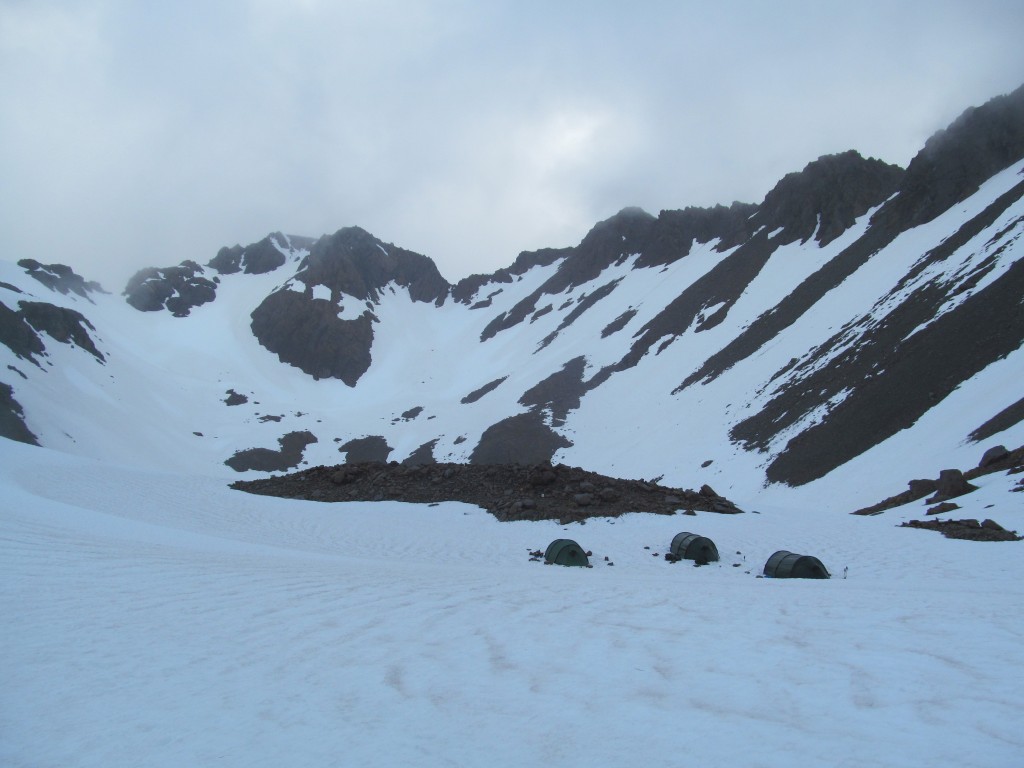“I like the sound of rain on the fly” Jim says, half prone in his red, mummy bag. “It is especially good when you know you don’t have to go anywhere, but it can be a bit daunting when you have to pack up.” We are in the latter category.
“Yeah, but luckily the fly usually amplifies the sound. It is not as bad as it sounds,” I add from my position at the door of the inner sanctum. I am sitting cross-legged, monitoring a pot of water that is on its way to boiling. Making breakfast if you will.
***
Forty-five minutes earlier our 0530 alarm pulled us from the peaceful and warm slumber into the wet cloudy world of Arthur’s Pass National Park and the Southern Alps. We are camped at the headwaters of Gorgy Creek and are looking at a long wet slog down into Tumbledown Creek, up and over Campbell Pass and then over a high snow covered pass to a small tarn on the western flank of Campbell Peak. Two days from now we need to be at the O’Malley Track trailhead to get more food and fuel. So we eat our mushy, warm, toasted muesli and oats, load our packs and stumble out of our shelter into the consistent drizzle of New Zealand’s main divide.
Thus far though we have been blessed by weather on this course. Only a few days out of ten or so have had the stamp of “classic” New Zealand weather. Around us the members of NOLS New Zealand’s semester number three are quickly disassembling tents. Students swing arms, swing legs and try to keep their blood flowing on this cool, damp morning. Today will be a long day at the office that is for sure. Over in the kitchen area I help Eric and Paul pick up a large amount of rice and pasta. We kneel on the rocky ground and pick the small white grains from between numerous marble sized rocks. The collection of rice, pasta and their intertwined blades of grass in my right hand slowly grows as we section it off and spend another ten minutes gathering it up. It is a job best avoided or at least better done the night before and made all the more difficult by the persistent drizzle on our backs.
Jim leaves first with five students. They descend into the cloud that has enveloped our camp. I hang back and enjoy and game of ninja and then the penguin dance with my group. We then begin our migration south in search of food.
The first leg of our travel takes us down and across the aptly named Gorgy Creek. Once across, we ascend the scree and tussock covered hillside beyond and stop for a quick break at the top. A scouting mission the day prior had shown the coming descent to be steep and exposed. We happily follow the beta and cairns of the scouting team and move down off the knoll. The clouds lift for a moment and we see Campbell Pass far below us. We will need to descend to Tumbledown Creek and then re-ascend the turpentine shrub and tussock filled hillside before reaching that milepost. But first we need to descend. We easily follow cairns and slowly pick our way down slippery snow grass and lichen and moss covered slabs and rocks. The crux of the descent is an exposed grassy ramp leading to a small rocky slot, down which we must pass. I turn around, easily down climb wet, but mostly solid sandstone and plant my feet on solid ground. Below me thirty meters of snow grass stretch down to a s small scree field. I start picking my way down the slope and quickly find myself sliding on my butt gathering speed. My hands reach out sideways and try to grasp anything. I dig my heels in and try to find some purchase on some of the gravel speeding by. I gain a little traction and it allows my hands to snatch a tussock. I slow down and stop. With out missing a beat I stand up and look around. Did anyone see that I wonder, slightly embarrassed. Above me Ben is standing at the top of the slot. “You all right?” he asks.

“Yeah, you know, I meant to do that. Wanted the quick way down “ I respond sheepishly. “Hold up there for a moment” I add. I move down, more cautiously this time, and drop my backpack at a small, protected alcove. I scramble back up, take Ben’s pack from him, and shuttle it down towards mine. I drop it then speed back up the slick grass and mud to spot Ben’s descent. Above Jim and his crew are approaching. Several more times I do the shuttle and soon my small group is clustered at the scree field.
“That is definitely the crux of the route,” Pauls says. “Yeah, except the rest of the day”, I think to myself. After giving a bit of assistance to Alex and Jim, we continue our descent toward Tumbledown Creek.
At our day’s low point we cross Tumbledown Creek. We clean our boots and gaiters with a dilute solution of salt and water as a means to stave off the hitchhiking didymo and start ascending. We travel upwards with turpentine shrub, mountain totora and tussocks providing the obstacles. We battle upward through the thick bush, making ample use of the handholds these tenacious plants provide. We crest the pass as clouds press down on us but pause anyway for a map check, snacks, and water. Soon a curious kea flies in and inspects our pausing posse. It hops about, inspects our packs and then offers a raucous cry before taking flight to more interesting things. The clouds lift briefly and the students spy a probable route up to our next saddle, or at least up into the clouds where we suspect our next saddle to be.
Fifteen hundred feet we climb, making our way out of the tussocks, into the sub alpine and finally, alpine. We trudge upward into the whiteout, handrailing an unnamed creek. The creek narrows and funnels us into an avalanche debris covered waterway. We kick steps up this narrow but gentle slope.
We near the creek’s end the clouds lift and we spy the pass for which we are aiming. An hour later we pause to scout our descent. The snow, clouds and slope allowed for a hassle free climb to the ridge’s low point. “Let me give it a look” I say to Paul and drop over the south side. The slope yields easily to a few aggressive plunge steps and I motion for Ben to come join me. I pause to wait and he catches up, his ice axe securely held across his chest, ready to self-arrest. I point down the hill to a “flat” area, which given the whiteout conditions is a bit hard to discern and tell Ben to continue down and pause near it. Soon Paul, Julia, Hannah and I all join Ben on the mellow slope below the saddle. We point our noses towards the small lake by which we hope to camp and plod onward. We are quickly rewarded with a long fast glissade to the snow and ice-covered lake’s shore. We tramp around it, drop packs and scout for a camp. We find some flat snow high on its southern edge and call it. Jim and his crew join us and we talk snow camping strategies. We all start the installation process setting sun breaks through the clouds in the western sky. Sixteen hours after our wet wake up, we settle in for a short night’s sleep before doing it all again tomorrow as we slowly make our way to our awaiting re-ration.
